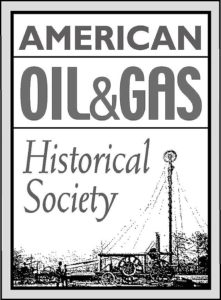Zebco Reel Oilfield History
Oilfield service provider Zero Hour Bomb Company in 1949 introduced its “cannot backlash” fishing reel.
Zebco oilfield history began well before 1947 when Jasper R. Dell Hull walked into the Tulsa offices of the Zero Hour Bomb Company. The amateur inventor from Rotan, Texas, carried a piece of plywood with nails arranged in a circle wrapped in line. His device included a coffee-can lid that could spin.
Hull, known by his friends as “R.D.,” had an appointment with executives at the Oklahoma oilfield service company. Incorporated in 1932, the Zero Hour Bomb Company was a leading manufacturer of dependable electric timer bombs used for fracturing geologic formations. The company designed and patented innovative technologies for “shooting” wells to increase oil and natural gas production.
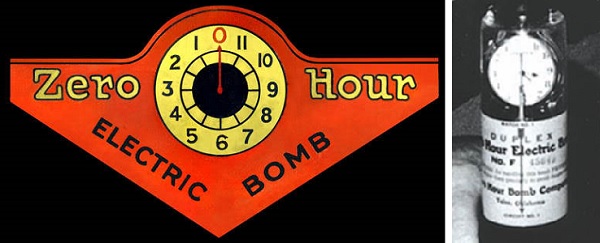
In 1932, the oilfield service company Zero Hour Bomb Company began manufacturing electric time bombs in Tulsa, Oklahoma. Photos courtesy Zebco.
Zero Hour Bomb Company’s timer controlled a mechanism with a detonator inside a watertight casing. The downhole device could be pre-set to detonate a series of blasting caps, which set off the well’s main charge, shattering rock formations.
Hull’s 1947 visit proved timely for Zero Hour Bomb Company, because post World War II demand for its electrically triggered devices had declined. With the military no longer needing oil to fuel the war, the U.S. petroleum industry faced a major recession.
The company and other once booming Oklahoma service companies were reeling, and the future did not look good.
“Vast fossil fuel reserves beneath other Middle Eastern nations were being unlocked,” noted journalist Joe Sills in a 2014 article. With OPEC beginning to take shape, Texas and Oklahoma-based oil production could only look forward to taking “a decades-long backseat to foreign oil.”
Further, with company patents expiring in 1948, “the Zero Hour Bomb Company needed a solution,” explained Sills, an editor for Fishing Tackle Retailer. After examining Hull’s contraption, a prototype fishing reel, the company hired him for $500 a month.
Meanwhile, as “fishing” petroleum wells helped recover downhole tools, Hull received a patent that transformed the Zero Hour Bomb Company — and sport fishing in America.
Downhole Patents
Beginning in the early 1930s, Zero Hour Bomb engineers patented many innovative oilfield products. A 1939 design for an “Oil Well Bomb Closure” facilitated the assembly of an explosive device capable of withstanding extreme pressures submerged deep in a well.
A 1940 innovation provided a hook mechanism for safely lowering torpedoes into wells. The locking method could “positively prevent premature release of the torpedo while it is being lowered into the well.”
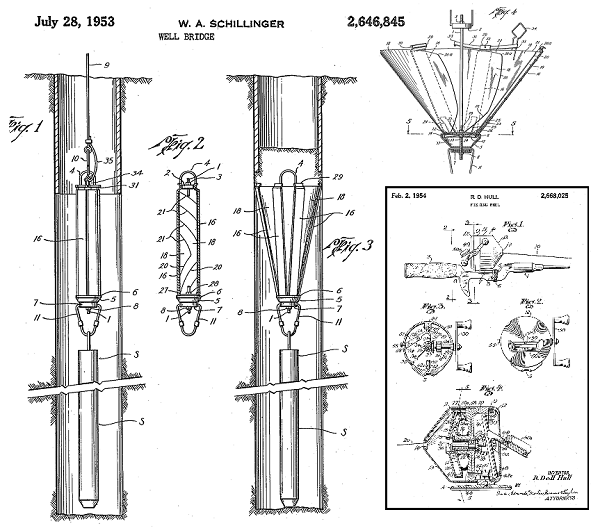
The July 28, 1953, patent for a canvas “well bridge” would be among the last Zero Hour Bomb Company received as an oilfield equipment manufacturer, thanks to R.D. Hull’s late-1940s design for a fishing reel (insert) illustrated in his February 2, 1954, patent.
The separate patent in 1941 improved positioning blasting cartridges using a plugging device made of canvas. It looked like an upside-down umbrella that automatically opened, “when the time bomb or weight reached a position at the bottom of the well.”
In 1953, an improved “well bridge” design took the concept even further, but it would be the last patent Zero Hour Bomb received as an oilfield equipment manufacturer. By then, the earliest model of Hull’s new “cannot backlash” reel attracted large crowds at sports shows.
Zebco Reels
“After trying to design ‘brakes’ for bait-casting reels, and even failing at launching one fishing reel company, Hull hit on a better way one day as he watched a grocery store clerk pull string from a large fixed spool to wrap a package,” reported Lee Leschper in a 1999 Amarillo Globe-News article.
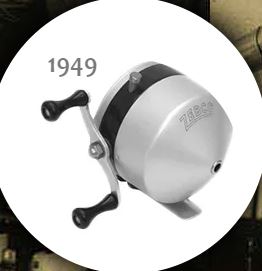
Zero Hour Bomb Company’s first “cannot backlash” reel made its public debut at a Tulsa sports expo in June 1949.
Hull realized he needed a cover to keep the line from spinning off the reel itself and soon developed a prototype, Leschper noted.
“Zero Hour officials asked two company employees who were avid fishermen for their opinions on the reel,” Leschper explained. “One tied his set of car keys to the end of the line and sent a cast flying through one of the windows in the plant. The other sent a cast high over the building. All were impressed.”
Given his own Hull-designed fishing reel at about age six, Leschper recalled, the “tiny black pushbutton reel” came with 6 lb. monofilament line (see Nylon, A Petroleum Polymer) and a four-foot hollow fiberglass rod. His small rig included a hard, yellow plastic practice plug. “I wore it down to a nub pitching it across the hard-baked grass in our front yard.”
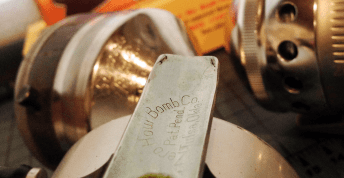
White House security officials in 1956 quickly submerged in water a Zero Hour Bomb Company package addressed to President Eisenhower. Photo courtesy Fishing Tackle Retailer magazine.
Earlier, Hull had tested several designs before developing a manufacturing process; the first reel debuted on May 13, 1949. Called the Standard, it made its public debut at a Tulsa sports expo in June. By 1954, the reel included the simple push-button system used today.
In 1961, Brunswick Corporation acquired Zebco — and introduced the 202 ZeeBee Spincast, “an instant classic.”
White House Insecurity
The regional marketing name — Zebco — became popular, but the bottom of each reel’s foot remained stamped with the name of the manufacturer: Zero Hour Bomb Company. The official name change to Zebco came in 1956 — soon after a friend of President Dwight D. Eisenhower asked the company to send a reel to the president.
According to a Zebco company history, when White House security officers saw the package labeled “Zero Hour Bomb Company,” they plunged it into a tub of water and called the bomb squad. After changing its name to Zebco, the company left the oilfield for good.
Jasper R. Dell “R.D.” Hull joined the Sporting Goods Industry Hall of Fame in 1975 after receiving more than 35 patents. At the time of his induction, 70 million Zebco reels had been sold. He retired from the former oilfield time-bomb company in January 1977 after being diagnosed with cancer and died in December at age 64.
___________________
The American Oil & Gas Historical Society (AOGHS) preserves U.S. petroleum history. Please become an AOGHS annual supporter and help maintain this energy education website and expand historical research. For more information, contact bawells@aoghs.org. © 2025 Bruce A. Wells.
Citation Information – Article Title: “Zebco Reel Oilfield History.” Authors: B.A. Wells and K.L. Wells. Website Name: American Oil & Gas Historical Society. URL: https://aoghs.org/oil-almanac/zebco-reel-oilfield-history. Last Updated: July 23, 2025. Original Published Date: February 20, 2018.



